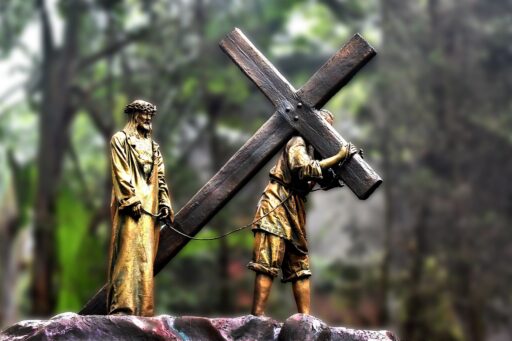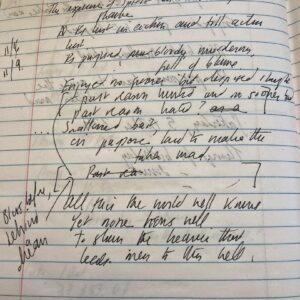In the four short stanzas (just 31 words) of his lyric poem, “Stations of the Cross” (Light Box, 2023), Patrick Morrissey crafts richly suggestive lines, at once elegant and direct, that hold powerful insights into devotion, memory, and violence.
Stations of the Cross At school, we learned the cruelty by heart— his anguished face and the supporting players, pale in the cloistered dark, lined up in stunned relief— a story we can’t stop telling.
“The stations of the cross” is a Roman Catholic devotion in which fourteen scenes depicting Christ on his way to crucifixion are recalled and pondered: his scourging, for instance, or his encounter with Pilate. Morrissey’s poem is titled Stations of the Cross (no “the”), suggesting parallel sites where “the cross” may be found. In addition to the immediate reference to Jesus’ historical suffering one may also read an implied immediate environment of school violence and beyond that innumerable instances of scapegoats and victimization in the wider world.
Few make it very far into their school years without encountering some form of scapegoating, where a minority group or individual is singled out for attack by a larger group that unites in excluding or attacking them. The inventive rhyme “school, we” and “cruelty” underscores the particular nature of the sort of group (the “we”) that is formed around a shared target. That is, the sense of group consciousness formed over against an excluded other. While learning the sufferings undergone by Jesus “by heart”—at once by rote and affectively—students are also learning, in classroom and schoolyard, a childhood version of the kind of ridicule and abuse dramatized in the devotion. Whether as bullies, victims, or “supporting players,” they would have a basis for relating to the violence depicted in the stations.
From a distance it may seem bizarre to imagine a room full of children poring over the brutal torture of a beloved figure and even stranger to be learning such scenes by rote. The expression “learned…by heart” conjures brilliantly the simultaneous musty tedium of pious memorization, the shocking violence (“cruelty”), and the complex impression left on “the heart.”
Just as in the title “Stations of the Cross,” the expected “the” is left out, so the second stanza begins with “his” (anguished face), not specifying the implied figure of Jesus, and so leaving the text open to other identifications, other victims. One might recall the “anguished” faces of children targeted by ridicule and violence in the classroom or schoolyard, and see oneself as a “supporting player” in the particular theatrical tableaux conjured by memory. “Supporting” here is another word loaded with multiple meanings: the chorus or backup cast members, of course, but also those offering support, either to Jesus in his suffering or to his perpetrators. The text, as the devotion, becomes a kind of examination of conscience, as readers are led to ask themselves where they have stood and where they stand, at these different stations.
The rhyming of “heart” with “dark” blurs the line between inside and out and suggests the heart as the origin of darkness. It is a “cloistered” dark which, while perhaps connecting to the nuns we might imagine as the teachers here, also implies a darkness (“cruelty”) that is organized, artificial, and contained. There is a scripted typological quality to the dynamics of scapegoat violence (and their later mythologization) picked out by such expressions, connected closely to other words that highlight the aesthetic quality of the stations: “players,” “cloistered,” “lined up,” “story.” On the other hand the same vocabulary invokes a metapoetic level where the artfulness of the poem (like the dramatic qualities in the depiction of the stations) aids memory and makes visible the real, sometimes brutal, dynamic of scapegoating instead of masking it in myth or ideology.
Another aesthetic term, “relief,” also holds multiple meanings. The “supporting players” appear in “stunned relief”—the visual, painterly “relief” in which “pale” figures are shown against a “dark” backdrop—but also their own “relief”: that the Galilean troublemaker is being silenced, that they are not themselves victims of such brutality, or perhaps even, from the perspective of the devout, relief at being saved through Jesus’ suffering. The “stations” (Jerusalem, classroom, worldwide) of the cross form “a story,” and like the poem itself a highly ambiguous one. As René Girard argued, Jesus’ death has the same structure as any of the other countless acts of scapegoat violence at the origins of culture. What makes it unique is that for the first time in history, texts (in the New Testament) present the “story” from the side of the innocent victim and possess a revelatory power able to expose and undermine the fundamental human structure of social violence, and to deconstruct its mythologization.
The progressively repeated “st” sound in the poem’s final four lines (“stunned,” “story,” “stop”) performs the inability to stop (telling). “Stations” are at once stopping points, positions along a path where one comes to a standstill, and markers on a journey that proceeds relentlessly forward to the cross. The fluency and naturalness of these last lines, along with the recurrent stuttering “st” sound, bring this to life in language. Meanwhile the “ee” sounds in “we” and “telling” circle back to the opening stanza to connect learning by heart (receptive repetition) with ceaseless telling (active repetition).
As Sebastian Moore makes clear in his classic The Crucified Jesus is No Stranger, each one of us is both crucified and a crucifier. This “story” that unfolds in (the) Stations of the Cross is one “we can’t stop telling” in a double sense: as crucifiers we can’t seem to stop making more victims despite, in some cases, professed allegiance to Christ; and as crucified, victims identified with Jesus in his anguish, or those “supporting” victims, “we can’t stop telling” the story out of both gratitude and a sense of how easily and subtly we fall back into “supporting” forms of violence despite ourselves. The poem’s brilliance lies in the way it demonstrates, with such compression and apparent simplicity, the irony of the cross, the fundamental ambiguity of an event we are always experiencing from two sides (crucifier and crucified). When both are not held in view together, victims turn into perpetrators and the violent forget that they began as victims and remain unhealed.
Isaac (John) Slater, a (Trappist) monk at the Abbey of the Genesee in New York, is the author of Beyond Measure: The Poetics of the Image in Bernard of Clairvaux along with a book and a chapbook of poems (Lean). Forthcoming titles include Never Judge Anyone: Desert Wisdom for a Polarized World (Liturgical, Spring, 2025) and a co-translation, This and That: Short Poems of Ryokan (Monkfish, Spring 2026).





